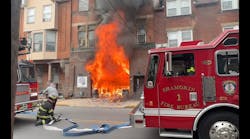Moments later, OCD updated the responding fire company of a reported building collapse at 601 N. Spaulding Ave., in the Fairfax District of Los Angeles. Task Force 61’s initial on scene size-up reported a three-story apartment building with heavy fire showing on all floors involving structural collapse and numerous occupants injured. The task force commander (Captain II) requested five additional task forces (10 companies) and five rescue ambulances. (An LAFD task force consists of one engine and one two-piece truck company.)
At 3:45 P.M., a six-seat Beechcraft Bonanza single-engine aircraft had lifted off from the Santa Monica Airport seven miles west of the 14-unit building, where it crashed through the roof and two floors before coming to rest in the parking garage underneath. Firefighters first on scene were confronted with a massive fuel-fed fire, burn and trauma injuries, and rescue and evacuation priority concerns. The Los Angeles Fire Department sent 22 fire companies to the major-emergency incident (15 or more companies working) and utilized six Los Angeles County Fire Department companies that responded both as automatic aid resources and as a mutual aid request.
Fire companies arriving on scene were divided into tactical areas of responsibility using standard incident command system assignments such as fire attack, triage, rescue, staging under the direction of Deputy Fire Chief Mario Rueda of the Bureau of Emergency Services. Units maintained a working presence on the scene for more than 48 hours. More than 130 firefighters worked at the scene of the incident prior to it being controlled.
The initial impact of the plane resulted in the deaths of five people, four on the plane and one occupant on the third floor of the apartment building. Firefighters transported seven people to medical centers for various injuries and treated and released others at the scene. An aggressive attack on the fire using roof trenching and interior handlines from ground ladders and inside the building resulted in a knockdown on the flames in approximately 30 minutes. At least four apartment units were destroyed and the others sustained water, heat or smoke damage.
A major component of the challenge to firefighters attempting search and rescue as well as fire attack was the compromised structural condition of the three-story building. As the aircraft struck the roof and fell through the two occupied floors and into the garage, a huge area of the interior of the structure also went to the ground. Although the exterior walls were not fractured, the mid-section of the rectangular wood-frame and stucco building had collapsed, and both living units and the center hallway as well as the roof were opened and unsupported. At least one firefighter was injured when falling through the third floor onto the second floor.
Urban Search and Rescue (USAR) teams from both fire departments worked at the incident and assisted in search and rescue. Once all occupants were accounted for and the fire had been extinguished, on-scene divisions and command directed everyone from the building, as structural evaluation, shoring and stability by LAFD USAR team members became the priority.
UNITS RESPONDING
Los Angeles Fire Department
- Engines 41, 52, 82, 9, 26
- Task Forces 27, 61, 29, 2, 58, 35, 15, 3
- USAR T/F 88
- Squad 4
- Heavy Rescue 56
- Rescue Ambulances 61, 52, 58, 68, 841, 861
- Engines 7, 8, 38
- Light Force 8
- Squads 7, 8
- USAR T/F 103
- Utility 1
- Battalion 1







